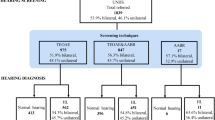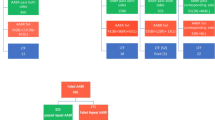Abstract
Purpose
Middle ear effusion (MEE) is one of the reasons for screening failure and may require prolonged follow-up due to conductive hearing loss. We aimed to examine at 1-year follow-up, the fate of MEE.
Methods
From medical charts, computerized data were collected retrospectively of newborns born in the years 2012–2013 in Rambam Health Care Campus, Haifa city, Israel, who failed the Universal Newborn Hearing Screening (UNHS), and follow-up hearing evaluation data were extracted.
Results
Of 9527 newborns born in 2012–2013 in our institution, 144 [1.5%] failed the UNHS, and 46 were eventually diagnosed with conductive hearing loss caused by MEE. Spontaneous MEE clearance was recorded in 12 [26%], while 26 [57%] patients had persistent effusion that required further follow-up (10 [22%] required insertion of ventilation tubes and 16 [35%] were referred for further follow-up); 8 [17%] were lost to follow-up.
Conclusion
Congenital MEE causing conductive hearing loss and UNHS failure is persistent and resolves at lower rates than non-congenital MEE.




Similar content being viewed by others
References
Gates GA, Klein JO, Lim DJ, Mogi G, Ogra PL, Pararella MM, Paradise JL, Tos M (2002) Recent advances in otitis media. 1. Definitions, terminology, and classification of otitis media. Ann Otol Rhinol Laryngol Suppl 188:8–18
Shekelle P, Takata G, Chan LS et al (2002) Diagnosis, natural history, and late effects of otitis media with effusion: summary. AHRQ evidence report summaries. Agency for Healthcare Research and Quality (US), Rockville, pp 1998–2005 (55)
Brennan-Jones CG, Whitehouse AJ, Calder SD, Costa CD, Eikelboom RH, Swanepoel DW, Jamieson SE (2020) Does otitis media affect later language ability? A prospective birth cohort study. J Speech Lang Hear Res 63(7):2441–2452
Rovers MM, Schilder AG, Zielhuis GA, Rosenfeld RM (2004) Otitis media. Lancet 363(9407):465–473. https://doi.org/10.1016/S0140-6736(04)15495-0 (Erratum in: Lancet. 2004;363(9414):1080)
Chen JL (2015) Newborn hearing screening may predict Eustachian tube dysfunction. Int J Pediatr Otorhinolaryngol 79(12):2099–2103
Liang J, Xiao L, Sun XY, Zou B (2021) Characteristics of the wideband absorbance of acoustic energy in children (3–7 years old) with otitis media with effusion. Int J Pediatr Otorhinolaryngol 140:110496
Casselbrant ML, Mandel EM (2003) Epidemiology. In: Rosenfeld RM, Bluestone CD (eds) Evidence-based otitis media, 2nd edn. BC Decker Inc., Hamilton, pp 147–162
Margolis RH, Levine SC, Fournier EM, Hunter LL, Smith SL, Lilly DJ (1992) Tympanic electrocochleography: normal and abnormal patterns of response. Audiology 31(1):8–24
Baldwin M (2006) Choice of probe tone and classification of trace patterns in tympanometry undertaken in early infancy. Int J Audiol 45(7):417–427
Zhiqi L, Kun Y, Zhiwu H (2010) Tympanometry in infants with middle ear effusion having been identified using spiral computerized tomography. Am J Otolaryngol 31(2):96–103
Harris PK, Hutchinson KM, Moravec J (2005) The use of tympanometry and pneumatic otoscopy for predicting middle ear disease. Am J Audiol 14(1):3–13
Gorga MP, Reiland JK, Beauchaine KA, Worthington DW, Jesteadt W (1987) Auditory brainstem responses from graduates of an intensive care nursery: normal patterns of response. J Speech Hear Res 30:311–318
Gorga MP, Kaminski JR, Beauchaine KL, Jesteadt W, Neely ST (1989) Auditory brainstem responses from children three months to three years of age: normal patterns of response. Part 2. J Speech Hear Res 32:281–288
British Columbia Early Hearing Program (BCEHP), BCEHP Audiology Assessment Protocol, 2012. http://www.phsa.ca/Documents/bcehpaudiologyassessmentprotocol.pdf
Swanepoel D, Ebrahim S (2009) Auditory steady-state response and auditory brainstem response thresholds in children. Eur Arch Otorhinolaryngol 266(2):213–219
Hatton JL, Janssen RM, Stapells DR (2012) Auditory brainstem responses to bone-conducted brief tones in young children with conductive or sensorineural hearing loss. Int J Otolaryngol 2012
Vohr BR, Letourneau KS, McDermott C (2001) Maternal worry about neonatal hearing screening. J Perinatol 21(1):15–20
Albright K, Finitizo T (1997) Texas hospitals’ quality control approach to universal infant hearing detection. Am J Audiol 6:88–90
Barsky-Firsker L, Sun S (1997) Universal newborn hearing screenings: a three-year experience. Pediatrics 99(6):e4
Mehl AL, Thompson V (1998) Newborn hearing screening: the great omission. Pediatrics 101(1):e4
Mason JA, Herrman KR (1998) Universal infant hearing screening by automated auditory brainstem response measurement. Pediatrics 101:221–228
Vohr BR, Carty LM, Moore PE, Letourneau K (1998) The Rhode Island Hearing Assessment Program: experience with statewide hearing screening (1993–1996). J Pediatr 133:353–357
Gravel JS, Tocci LL (2015) Setting the stage for universal newborn hearing screening. Int J Pediatr Otorhinolaryngol 79:2099–2103
Whitton JP, Polley DB (2011) Evaluating the perceptual and pathophysiological consequences of auditory deprivation in early postnatal life: a comparison of basic and clinical studies. Assoc Res Otolaryngol 12(5):535–547
Myers AK, Ray J, Kulesza RJ Jr (2012) Neonatal conductive hearing loss disrupts the development of the Cat-315 epitope on perineuronal nets in the rat superior olivary complex. Brain Res 1465:34–47
Graydon K, Rance G, Dowell R, Van Dun B (2017) Consequences of early conductive hearing loss on long-term binaural processing. Ear Hear 38(5):621–627
Tomlin D, Rance G (2014) Long-term hearing deficits after childhood middle ear disease. Ear Hear 35(6):e233–e242
Shetty HN, Koonoor V (2016) Sensory deprivation due to otitis media episodes in early childhood and its effect at later age: a psychoacoustic and speech perception measure. Int J Pediatr Otorhinolaryngol 90:181–187
Donadon C, Sanfins MD, Borges LR, Colella-Santos MF (2019) Auditory training: effects on auditory abilities in children with history of otitis media. Int J Pediatr Otorhinolaryngol 118:177–180
Boone R, Bower C, Martin P (2005) Failed newborn hearing screens as presentation for otitis media with effusion in the newborn population. Int J Pediatr Otorhinolaryngol 69:393–397
Weber BC, Whitlock SM, He K, Kimbrell BS, Derkay CS (2018) An evidence based protocol for managing neonatal middle ear effusions in babies who fail newborn hearing screening. Am J Otolaryngol 39(5):609–612
Roberts DG, Johnson CE, Carlin SA, Turczyk V, Karnuta MA, Yaffee K (1995) Resolution of middle ear effusion in newborns. Arch Pediatr Adolesc Med 149(8):873–877
Smolkin T, Mick O, Dabbah M, Blazer S, Grakovsky G, Gabay N et al (2012) Birth by cesarean delivery and failure on first otoacoustic emissions hearing test. Pediatrics 130(1):e95-100
Rosenfeld RM, Kay D (2003) Natural history of untreated otitis media. Laryngoscope 113(10):1645–1657
Petrova P, Freeman S, Sohmer H (2007) Mechanism and rate of middle ear fluid absorption. Audiol Neurootol 12(3):155–159
Boudewyns A, Declau F, Van den Ende J, Van Kerschaver E, Dirckx S, Hofkens-Van den Brandt A, Van de Heyning P (2011) Otitis media with effusion: an underestimated cause of hearing loss in infants. Otol Neurotol 32(5):799–804. https://doi.org/10.1097/MAO.0b013e31821b0d07
Funding
The study was partially funded by the dual Faculty of Social Welfare and Health sciences and the Rambam Health Care Campus grant awarded to Hanin Karawani and Arie Gordin.
Author information
Authors and Affiliations
Contributions
Conceptualization: HK, WM, AG; data curation: HK, WM, SN, AG; formal analysis: HK, WM, AG; formal analysis and investigation: HK, WM, SN, AG; writing—original draft preparation: HK, WM; writing—review and editing: HK, WM, AG; resources: HK, AG; supervision: HK, AG.
Corresponding author
Ethics declarations
Conflict of interest
The authors have no relevant financial or non-financial interests to disclose.
Ethics approval
This study was performed in line with the principles of the Declaration of Helsinki. Approval was granted by the Institutional Review Board of Rambam Health Care Campus (0671-18-RMB).
Additional information
Publisher's Note
Springer Nature remains neutral with regard to jurisdictional claims in published maps and institutional affiliations.
Rights and permissions
About this article
Cite this article
Karawani, H., Matanis, W., Na’ara, S. et al. Middle ear effusion and newborn hearing screening. Eur Arch Otorhinolaryngol 280, 643–649 (2023). https://doi.org/10.1007/s00405-022-07524-2
Received:
Accepted:
Published:
Issue Date:
DOI: https://doi.org/10.1007/s00405-022-07524-2




